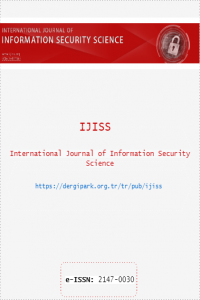A Scheme to Passcode Generation
A Scheme to Passcode Generation
Passcode, genetic information, biometric access system,
___
- J. Ding, S. Alsayigh, J. Lancrenon, S. RV, and M. Snook, "Provably Secure Password Authenticated Key Exchange Based on RLWE for the Post-Quantum World," in Topics in Cryptology – CT-RSA 2017: The Cryptographers’ Track at the RSA Conference 2017, San Francisco, CA, USA, February 14–17, 2017, Proceedings, H. Handschuh, Ed., ed Cham: Springer International Publishing, 2017, pp. 183-204.
- C.-M. Chen, W. Fang, K.-H. Wang, and T.-Y. Wu, "Comments on “An improved secure and efficient password and chaos-based two-party key agreement protocol”," Nonlinear Dynamics, vol. 87, pp. 2073-2075, February 01 2017.
- M. S. Farash and M. A. Attari, "An efficient and provably authenticated key exchange protocol based on Chebyshev chaotic maps," Nonlinear Dynamics, vol. 77, pp. 399-411, July 01 2014. password-based
- X. Guo and J. Zhang, "Secure group key agreement protocol based on chaotic Hash," Information Sciences, vol. 180, pp. 4069-4074, 2010/10/15/ 2010.
- T.-F. Lee, "Enhancing the security of password authenticated key agreement protocols based on chaotic maps," Information Sciences, vol. 290, pp. 63-71, 2015/01/01/ 2015.
- J. W. Kalat, Introduction to psychology: Nelson Education, 2016.
- A. Y. Bani Hashim, "Development of Artificial Intelligent Control," Universiti Putra Malaysia, 2002. for Manipulator Position
- H. Ismail and K. Hon, "The nesting of two-dimensional shapes using genetic algorithms," Proceedings of the Institution of Mechanical Engineers, Part B: Journal of Engineering Manufacture, vol. 209, pp. 115-124, 1995.
- J. Psarras, "GA-based decision support systems in production intelligent systems technologies and applications, vol. 2, pp. 58-76, 2006. International journal of
- A. Y. Bani Hashim, "Representing System by Gene Encoding," International Journal of Research and Reviews in Computer Science, vol. 2, pp. 247-249, 2011.
- W. Wang and P. Brunn, "An effective genetic algorithm for job shop scheduling," Proceedings of the Institution of Mechanical Engineers, Part B: Journal of Engineering Manufacture, vol. 214, pp. 293-300, 2000.
- G. Liu, X. Jiang, and L. Wen, "A clustering system for gene expression data based upon genetic programming and the HS-model," in Computational Science and Optimization (CSO), 2010 Third International Joint Conference on, 2010, pp. 238-241.
- Y. Chen, C. J. Tang, R. Li, M. F. Zhu, C. Li, and J. Zuo, "Reduced-GEP: programming by gene reduction," in Intelligent Human- Machine Systems and Cybernetics (IHMSC), 2010 2nd International Conference on, 2010, pp. 176-179.
- Yayın Aralığı: Yılda 4 Sayı
- Başlangıç: 2012
- Yayıncı: Şeref SAĞIROĞLU
PairTRU: Pairwise Non-commutative Extension of The NTRU Public key Cryptosystem
Amir Hassani KARBASİ, Reza Ebrahimi ATANİ, Shahabaddin Ebrahimi ATANİ
Security of NEQR Quantum Image by Using Quantum Fourier Transform with Blind Trent
A Scheme to Passcode Generation
DDoS attacks and impacts on various cloud computing components
